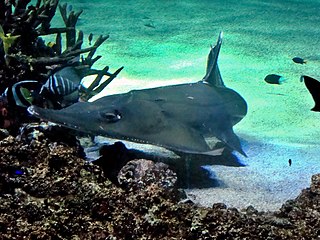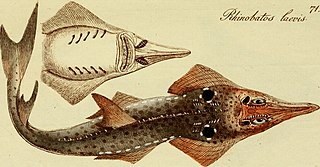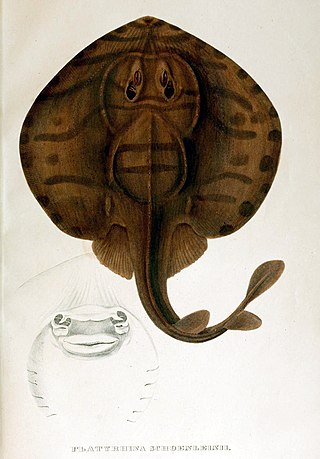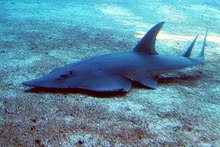
Myliobatiformes is one of the four orders of batoids, cartilaginous fishes related to sharks. They were formerly included in the order Rajiformes, but more recent phylogenetic studies have shown the myliobatiforms to be a monophyletic group, and its more derived members evolved their highly flattened shapes independently of the skates.

The guitarfish, also referred to as shovelnose rays, are a family, Rhinobatidae, of rays. The guitarfish are known for an elongated body with a flattened head and trunk and small, ray-like wings. The combined range of the various species is tropical, subtropical, and warm temperate waters worldwide.

Rhina ancylostoma, the bowmouth guitarfish, shark ray or mud skate, is a species of ray and a member of the family Rhinidae. Its evolutionary affinities are not fully resolved, though it may be related to true guitarfishes and skates. This rare species occurs widely in the tropical coastal waters of the western Indo-Pacific, at depths of up to 90 m (300 ft). Highly distinctive in appearance, Rhina ancylostoma has a wide and thick body with a rounded snout and large shark-like dorsal and tail fins. Its mouth forms a W-shaped undulating line, and there are multiple thorny ridges over its head and back. It has a dorsal color pattern of many white spots over a bluish gray to brown background, with a pair of prominent black markings over the pectoral fins. This large species can reach a length of 2.7 m (8.9 ft) and weight of 135 kg (298 lb).

The giant guitarfish, also known as the whitespotted wedgefish, is a large species of guitarfish in the family Rhinidae. It is restricted to the Red Sea, Persian Gulf, and western Indian Ocean, but was formerly considered more widespread due to confusion with its relatives.

Rhynchobatus australiae, also called the white-spotted guitarfish, white-spotted wedgefish or bottlenose wedgefish, is a species of fish in the Rhinidae family. It is found from shallow waters to a depth of at least 60 m (200 ft) in the Indo-Pacific, ranging from the East African coast and the Red Sea, to Taiwan, the Philippines and Australia. It is part of a species complex that also includes the giant guitarfish, the broadnose wedgefish and possibly the smoothnose wedgefish.

Rhynchobatus is a group of rays commonly known as wedgefishes in the family Rhinidae. They are found in the tropical and subtropical Indo-Pacific with a single species in the eastern Atlantic. All species in this genus are assessed as Vulnerable or Endangered by IUCN.

The smoothnose wedgefish is a species of fish in the Rhinidae family. It is found in northern Indian Ocean and northwestern Pacific Ocean, ranging from the Arabian Sea and Persian Gulf east to Bangladesh, and South China Sea to southern Japan. Populations elsewhere are now recognized as separate species. Its natural habitat is shallow coastal seas and off the mouths of rivers. It is threatened by habitat loss and overfishing.

The African wedgefish, guitarra, Lubbert's guitarfish, or spikenose wedgefish is a species of fish in the Rhinidae family. It is the only species in its genus to occur in the East Atlantic.
The roughnose wedgefish is a species of fish in the Rhinidae family. It is found in Indonesia and Singapore. Its natural habitats are open seas, shallow seas, coral reefs, estuarine waters, and coastal saline lagoons. It is threatened by habitat loss. Despite having been known for more than a decade, it remained undescribed until 2016. This is a relatively small species, reaching up to 81 cm (2.66 ft) in length. Adults are greenish-brown above; young have white spots.
The broadnose wedgefish is a species of fish in the Rhinidae family. It is found in coastal and estuarine habitats in southeast Asia, where documented from Java, Borneo, Singapore, the Philippines and Thailand. It is threatened by habitat loss and overfishing. This is a medium-sized species of Rhynchobatus, which reaches a maximum length of about 2.15 m (7.1 ft).
Tarsistes philippii is a taxonomically dubious species of guitarfish, family Rhinobatidae. It is known only from a dried head from the Juan Fernández Islands off Chile. The head had a long, thin, flat snout, rounded at the tip like that of the goblin shark, and the underside covered with small stellate prickles except for the base. The head was covered with larger spinules, with six still larger ones forming a curve around the eye.

Glaucostegus, also known as giant guitarfishes, is a genus of large Indo-Pacific rays, with a single species, Glaucostegus cemiculus, in the East Atlantic, and Mediterranean. They were formerly classified in the family Rhinobatidae but are now recognized as a distinct family, Glaucostegidae.
Rhynchobatus palpebratus, the eyebrow wedgefish, is a species of fish in the Rhinidae family. It is found in coastal waters off northern Australia. It reaches up to 2.62 m (8.6 ft) in length and closely resemble the smoothnose wedgefish, which has denser white spotting, and also differ in distribution and genetics.

Rhinopristiformes is an order of rays, cartilaginous fishes related to sharks, containing shovelnose rays and allied groups.
The false shark ray is a species of fish in the Rhinidae family and the only species in the genus Rhynchorhina. This rare ray is only known from shallow coastal Atlantic waters in Banc d’Arguin, Mauritania.

The panrays are a genus, Zanobatus, of rays found in coastal parts of the warm East Atlantic Ocean, ranging from Morocco to Angola. It is the only genus in the family Zanobatidae, which traditionally has been included in the Myliobatiformes order, but based on genetic evidence it is now in Rhinopristiformes or a sister taxon to Rhinopristiformes.

Acroteriobatus is a genus of fish in the Rhinobatidae family. Although its constituent species were previously assigned to Rhinobatos, recent authors treat it as distinct.

Pseudobatos is a genus of fish in the Rhinobatidae family. Although its constituent species were previously assigned to Rhinobatos, recent authors treat it as distinct.
Rhynchobatus mononoke, the Japanese wedgefish, is a species of fish in the family Rhinidae. It is found in southern Japan.











